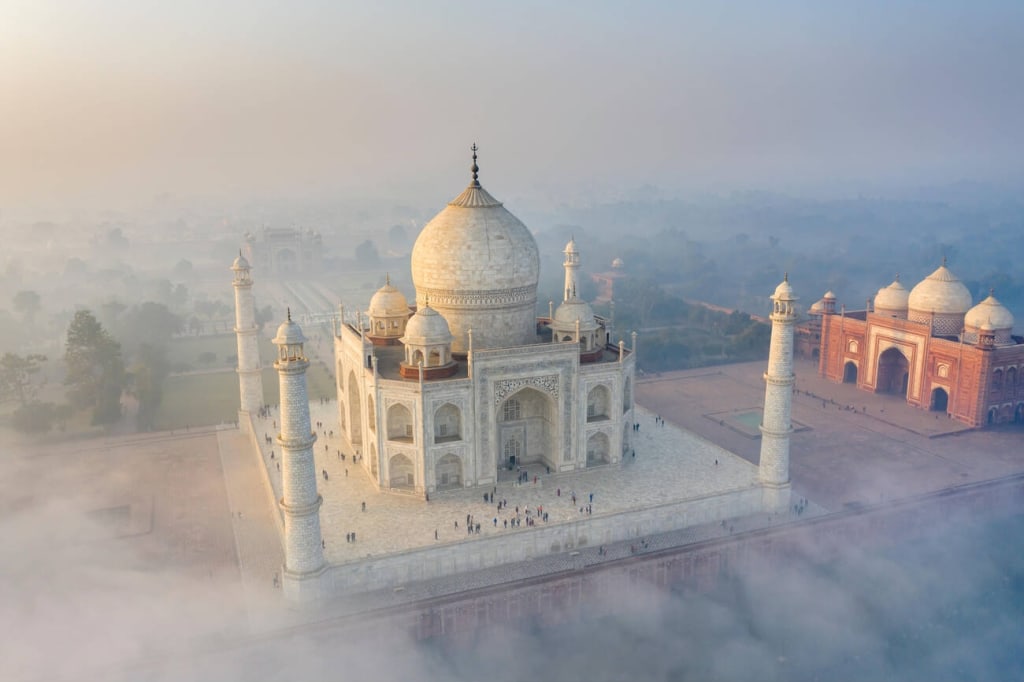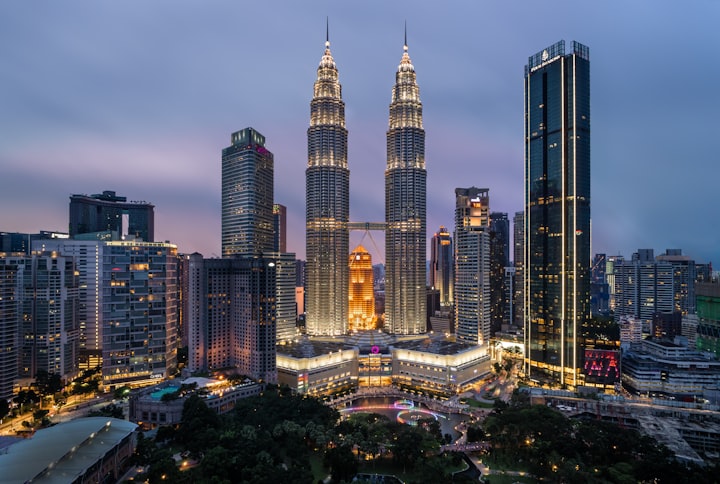Top 3 The Most Beautiful Places In India
You Have To See In 2022 Believe!

1.Beauty Of The Taj Mahal
Taj Mahal is a stunningly beautiful mausoleum, built in white marble from 1631 to 1648, by a man named Mahatma. The wonder on marble, Taj Mahal was built by Mughal emperor Shah Jahan to honor his favorite wife, Empress Mumtaz Mahal. An enormous white marble mausoleum built at Agra between 1631 and 1648 on orders from the Mughal emperor Shah Jahan to remember his favorite wife, the Taj Mahal is a pearl of Muslim art in India and is one of the universally-admired masterpieces of world heritage. Located outside of the city of Agra, in Uttar Pradesh, North India, the Taj Mahal is among the finest architectural masterpieces of the world.
The Taj Mahal has given a worldwide identity to Agra. The Taj Mahal, recognized as one of the greatest treasures of Indian culture, is located on the banks of the river Yamuna on the city's Yamuna river, about 130 miles south of New Delhi. The Taj Mahal is not just beautiful due to being a fabulous monument made from marble, but it is marvelously situated on the sacred banks of the Yamuna river. Taj Mahal has five major structures, namely, the Darwaza (Main Gateway), the Bageecha (Garden), the Masjid (Movement), Naqqar Khana (Resting House) and Rauza (Mausoleum), which houses the Tomb.
The beauty of black writing on the white marble is the appealing aspect of Taj Mahal. Rated one of the Seven Wonders of the world, selected by the people across the world in the year 2000, Taj mahal's white marble has taken a greenish-brown hue. The arches and domes of the Taj are a stunning contrast against the lush green landscape, the blue skies, and the red pathways leading up to the monument. The walls changing colors give the Taj Mahal a feeling that it is alive and full of magic, and its almost-perfect symmetry exudes a feeling of peace and harmony.
The architectural beauty of the Taj Mahal has earned it two prestigious titles, Unesco's World Heritage Site and one of the seven wonders of the world. The Taj Mahal is a masterpiece of architectural style in concept, treatment, and execution, and has a unique aesthetic quality of poise, symmetry, and harmonious integration of diverse elements. The elaborately designed gardens are said to depict perfection and beauty of the sky reproduced on Earth, which fits well into the themes of the architecture of the Taj Mahal itself. From its use of white marble, a central burial axis, and lateral axis, nearby Itmad-ud-Daulahas tomb marks a new age in Mughal architecture and sets an architectural basis for Taj Mahal.
Mughal emperor Shah Jahan had a fascination with buildings and architecture, and besides the Taj Mahal, constructed several other popular monuments including Agra Fort and Red Fort, as well as the Jama Masjid in Delhi.
2.Mysore Palace Is Very Beautiful
Mysore Palace is one of the finest Royal palaces located in the princely state of Mysore. Apart from the Mysore Palace, there are a lot of lesser known, yet beautiful Royal buildings scattered around Mysore. Often called as The City of Palaces, this royal town still holds the charms of old-world style, thanks to its palaces, heritage buildings, traditions, and temples.
Mysore is home to a number of beautiful palaces, with the amazing Mysore Palace being the most popular. The few beautiful palaces are proof of the Wodeyars taste and skill of craftsmen that built these palaces, it is fitting Mysore is called a palace town. The walls of Mysore Palaces amazing architecture are also lined with murals that show the Mysore Dasara, and fine carvings depicting the lineage of Wodeyars royal history. In addition to these, the incredible Mysore palace also has a gombe thotti (dolls gazebo), multiple temples, courts, and is surrounded by beautiful landscaped gardens.
Also called the Amba Vilas Palace, the Mysore palace is one of the most splendid and largest palaces in India. Mysore Palace, also known as Amba Vilas Palace, located at the center of the city of Mysore is Mysores most famous tourist attraction, drawing millions of visitors throughout the year. Mysore Palace is one of Indias best-known tourist attractions (after Taj Mahal) that draws around 6 million visitors every year. Lalitha Mahal Palace is one of the most beautiful palaces of south India and is also a major tourist spot of Mysore.
The architecture of the Amba Vilas Palace, Mysore is composed of three-storey building made from polished gray granite, featuring a deep rose-colored marble dome, together with numerous arches. The fortress-like complex Alhambra is without doubt the most famous of Indian cities, dating from 1912, formerly home of the Wadiyar dynasty. Commissioned by Krishnarajendra Wodeyar IV, Mysore Palace comprises of two Durbar Halls, numerous giant courts, buildings, and stunningly beautiful gardens, which speaks volumes about the splendour of the Wadiyars. The elaborately pillared Durbar Hall, solid silver doors, delicately incised mahogany ceilings and several other decorations in the Palace leave the visitor enchanted, giving a glimpse into the ostentatious lifestyle of the Maharajas of Mysore.
The architectural style of Mysore palace is a mix of Hindu, Mughal, Rajput, Gothic styles, with domes described as Indo-Sarcasian. Mysore Palace houses a variety of Wodeyars precious belongings, including mementos, jewellery, royal costumes, and paintings.
Karanji mansion is one of the popular palaces located at the Nazarbad mohalla of Mysore. Jayalakshmi Vilas Mansion is one of the breathtakingly beautiful palaces situated in the tall crest in Mysore University Campus.
3.Golden Temple Of Amritsar – India’S Shining Star
The Golden Temple of Amritsar, also known as the Harmandir Sahib (Adoption of God) or Darbar Sahib (High Court), is the most well-known religious centre of the Sikhs of India. The sacred gurdwara was our first Sikh temple. After dropping our bags off at reception, we started walking to the Sri Harmandir Sahib -- the golden shrine in Amritsar -- the most venerated of Sikh temples.
Amritsar's golden temple is, in and of itself, surrounded by other temples in milky white, as well as the moat. The temple, and the pools surrounding it, are the compound known to Sikhs as a Gurdwara, spiritual site, a unity seat. The Golden Temple in Amritsar has survived over centuries, but only because the Sikhs continued rebuilding it after its destruction at the hands of Afghan forces and Mughal empire.
Amritsar City was initially built around the Golden Temple, but the area surrounding the Temple is not now a central part of Amritsar. Our first Sikh temple was only a very small portion of the Gurdwara Complex, but it is the tanks or tanks surrounding the Golden Central Sanctuary which is Amritsar's spiritual center. Spiritually, the focus of attention is the tank surrounding the shining central shrine -- Amrit Sarovar, after which Amritsar takes its name, was dug up in 1577 by the fourth Sikh Guru, Ram Das.
The building of Sri Haramandir Sahib was started by Guru Arjan, the fifth Sikh Guru. The Haramandir Sahib was repeatedly destroyed by Afghan intruders, and was eventually rebuilt with marble and copper, with a gold-foil finish, during the rule (1801-39) of Maharaja Ranjit Singh. The golden temple, also known as the Sri Harmandir Sahib The Sri Harmandir Sahib is a religious Sikh shrine that is held in high veneration, symbolizing equality and brotherhood among mankind.
Lord Buddha declared the place an ideal place of meditation for the sadhus and the holy people. Long before the construction of the Golden Temple, Guru Nanak, the first Sikh Guru, used to meditate in this sacred place. Once Guru Gobind Singh, the 10th Guru, died in 1708, the Guru Granth Sahib (Sacred Scripture) became a spiritual guide to the Sikhs.
In 1802, Guru Gobind Singh, aged 22, took Amritsar from Bhangi Sikh Misl, paid tribute to the Golden Temple, and announced he was going to renovate and reconstruct it using marble and gold. Sri Harmandir Sahib plays a pivotal role in the rich Punjabi history, making Shri Harmandir Sahib a sacred pilgrimage destination for the Sikhs. The Golden Temple is an unbroken combination of stunning architecture, warm hospitality, and mesmerizing tranquillity. On special occasions like birth anniversary of Sikh Gurus or any major occasion of Sikh Community, the Golden Temple turns into a glistening visual treat with the Golden Lights and their reflections on a sacred lake.
Treat with the Golden Lights and their reflections on a sacred lake.





Comments
There are no comments for this story
Be the first to respond and start the conversation.